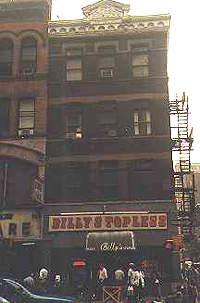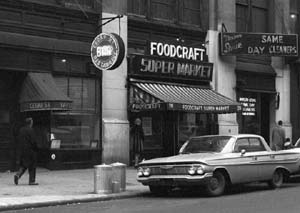Sex as a Museum Piece
John Haberin New York City
Museum[s] of Se[x]
de Kooning: An American Master
I lived five years over a topless bar and never once went in. I was proud of it—the bar, that is. We had occupied an illegal loft so that my best friend could paint, and no one then would have dared call it Chelsea. Billy's Topless only confirmed that we were way over the edge and way too cool to care.
What of another topless joint that happens to call itself a museum? And what of another bar that pops up in the life of an artist and the women he thought he knew? Enter here. 
The facts of life
Each night I'd find reassurance in the blue lights below and the silhouettes of water towers high above. Over time, my eyes turned more and more toward the sky, as the novelty of the bar and the pathetic old men I imagined inside wore off.
Yet the dark outlines of both still define New York for me, for all its visible change. It is no longer the crime scene photographed by Jill Freedman. My friend gave over studio space to family long ago, and his son grew up in sight of that same corner, only now it is a bagel shop. Different curves; a different hole.
I live just across town now, over the Museum of Sex, and I have not gone in there either. Well, actually I live four long blocks away, but it feels awfully, creepily close, as a dive never could. Once again I need to know that I am too sophisticated ever to go inside. I need even more to know I am in on the joke.
Would a museum of sex start with the first sex act ever, what Eve said to the serpent? Would it mark my own sex life as, at best, a museum piece? Chief curator Grady Turner brings the pedigree of the New-York Historical Society, as quaint and authoritative as its hyphen—yet another act of illicit coupling. Would it have prim, protective glass cases for Marquis de Sade's personal papers or a first edition of Lady Chatterly's Lover? I guess not.
Now that I pass my life writing about museums, I find it still harder to go in. Will this one have a gift shop, but selling vibrators? Will it display porn as art—perhaps Asian porn, to capitalize on a fashion for anime and the mystique of Kama Sutra?
Will it take no notice of a woman's sexual agency? Perhaps it could show a portrait bust not of Monica Lewinsky but of Hillary Clinton, as if to rub it in. Will it immerse one in a dark, hazy blue light, to take the pressure off? You should not have to imagine others looking at you. You should not have to decide when to touch that person you were foolish enough to bring along.
Boundaries of legitimacy
This time I have everything right. Indeed, when a friend went this very summer, she had to face all these, plus a suitably lurid, pretentious display of sexual paraphernalia. Naturally, she shall remain anonymous. I take a certain pleasure in knowing that Jackson Pollock and Lee Krasner married at the church just one block up Fifth Avenue. Almost immediately after, Krasner and Pollock left New York for eastern Long Island, a renewed artistic creativity, and, ultimately, a dangerous love affair.
Yet one cannot quite keep a Museum of Sex's challenge to art, the art of museums, at arm's length. With those words museum and sex, I can trace some all too familiar commercial instincts.
Other museums, too, lean to images of women, mostly by and for men. They, too, have a gift shop out front, for impulse buyers in more ways than one. Low lighting recalls the disorientation of stumbling into museum rooms for video art. Talk about sex, lies, and videotape.
Boundaries of legitimacy keep slipping, and not solely because of slippery definitions of art or art's now uncertain power to shock and transgress. My friend went so that she could write a paper for a course in contemporary art. Artists these days freely incorporate frank confessions and images of sex, even cartoon ones. Scholars have pored over the origins of romantic love and the family.
Mass culture has made sex a fact of life anyway. Who needs a Museum of Sex when Sue Williams, Lisa Yuskavage, Tracey Emin, and Ghada Amer—to name women for a change—can face off against Vanity Fair, with Annie Leibovitz and "Global Feminisms" now featured at the Brooklyn Museum?
Maybe the time has come for a different kind of Museum of Sex, with other desires, with those dark rooms a hall of mirrors, and with a potential unrealized even in a strip joint. Perhaps "WACK! Art and the Feminist Revolution" to come at P.S. 1 will supply one. Then again, maybe the actual Museum of Sex really does reduce to mere exploitation and a bad joke. And maybe one day, then, I can safely go in.
. . .
Woman I
If I do, I may learn a little more about history—starting, perhaps, with that couple who wed just up the street. And what of their rivals? Perhaps women in the arts have long had that assurance that they could face off against the best of them. Perhaps they have long found themselves facing the same fractured world as well. Perhaps they ran into both at yet another vanished New York bar.
In a catalog essay on Elizabeth Murray, Robert Storr reels off more than a dozen women on the radar of 1950s art, as measured by a "yearbook" edited by Robert Motherwell and Ad Reinhardt before Reinhardt's black paintings. He could have added Janet Sobel, who dealt on equal terms with drip painting and outsider art. He could have mentioned Mercedes Matter, a friend of Pollock's who may have emulated him so well that only fractal analysis knows for sure.
While I cannot swear that art history has overlooked many of Storr's names, I certainly have. They serve as a rebuke to the past or present status of women in the arts. They serve as a rebuke, Storr observes, to the movement as well, for only one woman appeared in a famous photo of the "irascibles." They could also be telling off Jed Perl for his New Art City, which cherishes the walk-ons in postwar art's drama for their "quieter yearning" as opposed to "Warholism." Storr is clearly hoping that a more considered view of modern art will shake things up, not restore peace and quiet.
Conversely, Storr's aside in no small part actually defends the mainstream. See, it says, a period surrounded by masculine myths welcomed women, more or less, and traditional critics like Storr already take them quite seriously, thank you. He makes an interesting contrast to a prize-winning biography of Willem de Kooning, by Mark Stevens and Annalyn Swan.
Stevens and Swan have written the best artist biography I know, and I hope that I can return to it again. They evoke human voices, to the point that one can almost hear de Kooning talking, his Dutch accent and quirky humor intact. One can feel his pride in his early commercial work. One can share his felt tributes to older artists, such as Stuart Davis or Gorky, and his graciousness toward younger ones.
Women, however, do not come off half so well. Stranger still in a biography with a woman as co-author, they feed Abstract Expressionism's almost primal male myth.
Woman II
In their biography of Pollock a few years ago, Steven Naifeh and Gregory White Smith played up that artist's "American saga." Jeffrey Potter similarly sets the tone of his oral biography with its title, To a Violent Grave. Hayden Herrera's life of Arshile Gorky describes a fragile male ego haunted by the loss first of his mother and then of his wife. With Stevens and Swan, however, women may absorb a man and his affections, but he outlasts them all.
I loved reading about Robert Rauschenberg, as he shyly requests two drawings to erase. Of course, de Kooning draws out the occasion until he finds a work good enough to destroy. Stevens and Swan do just as well at evoking a vanished New York, on some of the same streets as my own vanished city, especially the ever-changing haunts and recourses of impoverished painters. Moreover, when they stop to interpret a work, everything they have covered informs it—except, at times, the ones de Kooning may or may not have loved most. 
The artist's mother seems, to put it mildly, a real piece of work. In turn, de Kooning agonizes over his failures as a parent, while his daughter uses his place near the East Village to live it up. When he marries Elaine Fried, he builds a loft for them both like the house in a fairy tale, getting down on his knees to scrub and scour every inch of the floor. She, in turn, lives for his reputation because it sustains her importance as well, to the point of its coloring when and where she sleeps around.
Krasner put up with plenty to sustain Pollock's life and career, while creating remarkable work and even keeping her intelligence intact. Yet she, too, appears here mostly so that she can battle Elaine over which male gets to call himself alpha. The gendered metaphor of a "cat fight" tells much of the story, and I say that knowing that cats come in two sexes.
In a memorable scene, Pollock and de Kooning exit another dive together—the Cedar Bar—to trade drinks out front, along with alternating claims that "no, you are the greatest living artist." The men resolve conflict the proper way, with generosity, honor, and plenty of booze.
Ironically, with a book this superb, one cannot dismiss that Stevens and Swan have captured the reality of a male-dominated generation better than Storr's more balanced portrayal after all. The Cedar Bar has not really vanished. It has merely moved one block north. But what memories does it preserve? Maybe it makes sense that Pollock and Krasner wed just up the street from the Museum of Sex.

A shorter, no doubt funnier and more focused version of this article (roughly the first half) appears in Artillery magazine (December 2006), without discussion of de Kooning: An American Master by Mark Stevens and Annalyn Swan (Knopf, 2004). Did I really live over a topless bar? Did I really never go into the Museum of Sex? You can ask my friend, but she is not talking. Billy's did exist, succumbing in 2001 to New York's quality of life campaign and luxury high-rise development along Sixth Avenue. The Cedar Bar (photographed by Robert Otter) moved after a fire, to where students frequent it today. Oh, and those bagels are so-so by New York standards—and, as of late 2009, have vanished, too.




